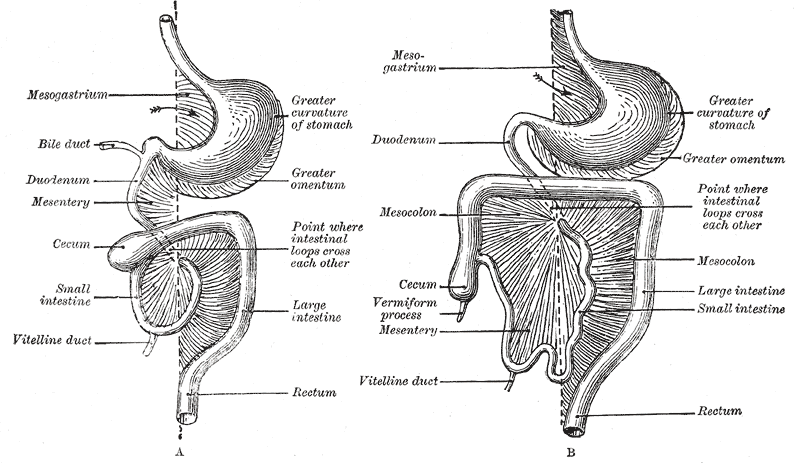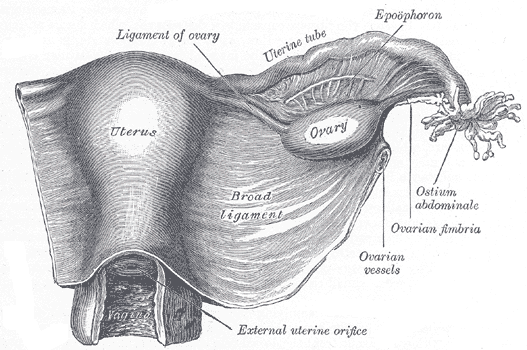|
Broad Ligament Of The Uterus
The broad ligament of the uterus is the wide fold of peritoneum that connects the sides of the uterus to the walls and floor of the pelvis. Structure Subdivisions Contents The contents of the broad ligament include the following: * Reproductive ** uterine tubes (or Fallopian tube) ** ovary (some sources consider the ovary to be on the broad ligament, but not in it.) * vessels ** ovarian artery (in the suspensory ligament) ** uterine artery (in reality, travels in the cardinal ligament) * ligaments ** ovarian ligament ** round ligament of uterus ** suspensory ligament of the ovary (Some sources consider it a part of the broad ligament, while other sources just consider it a "termination" of the ligament.) Relations The peritoneum surrounds the uterus like a flat sheet that folds over its fundus, covering it anteriorly and posteriorly; on the sides of the uterus, this sheet of peritoneum comes in direct contact with itself, forming the double layer of peritoneum known as ... [...More Info...] [...Related Items...] OR: [Wikipedia] [Google] [Baidu] |
Uterus
The uterus (from Latin ''uterus'', plural ''uteri'') or womb () is the organ in the reproductive system of most female mammals, including humans that accommodates the embryonic and fetal development of one or more embryos until birth. The uterus is a hormone-responsive sex organ that contains glands in its lining that secrete uterine milk for embryonic nourishment. In the human, the lower end of the uterus, is a narrow part known as the isthmus that connects to the cervix, leading to the vagina. The upper end, the body of the uterus, is connected to the fallopian tubes, at the uterine horns, and the rounded part above the openings to the fallopian tubes is the fundus. The connection of the uterine cavity with a fallopian tube is called the uterotubal junction. The fertilized egg is carried to the uterus along the fallopian tube. It will have divided on its journey to form a blastocyst that will implant itself into the lining of the uterus – the endometrium, where it will ... [...More Info...] [...Related Items...] OR: [Wikipedia] [Google] [Baidu] |
Round Ligament Of Uterus
The round ligament of the uterus is a ligament that connects the uterus to the labia majora. Structure The round ligament of the uterus originates at the uterine horns, in the parametrium. The round ligament exits the pelvis via the deep inguinal ring. It passes through the inguinal canal, and continues on to the labia majora. At the labia majora, its fibers spread and mix with the tissue of the mons pubis. Development The round ligament develops from the gubernaculum which attaches the gonad to the labioscrotal swellings in the embryo. Blood supply The round ligament is supplied by the artery of the round ligament of uterus, also known as ''Sampson's artery''. Function The function of the round ligament is maintenance of the anteversion of the uterus (a position where the fundus of the uterus is turned forward at the junction of cervix and vagina) during pregnancy. Normally, the cardinal ligament is what supports the uterine angle (angle of anteversion). When the uterus gro ... [...More Info...] [...Related Items...] OR: [Wikipedia] [Google] [Baidu] |
Parametrium
The parametrium is the fibrous and fatty connective tissue that surrounds the uterus. This tissue separates the supravaginal portion of the cervix from the bladder. The parametrium lies in front of the cervix and extends laterally between the layers of the broad ligaments. It connects the uterus to other tissues in the pelvis. It is different from the perimetrium, which is the outermost layer of the uterus. The uterine artery and ovarian ligament are located in the parametrium. An associated form of pelvic inflammatory disease is inflammation of the parametrium known as parametritis Parametritis (also known as pelvic cellulitis) is an infection of the parametrium (connective tissue adjacent to the uterus The uterus (from Latin ''uterus'', plural ''uteri'') or womb () is the organ in the reproductive system of most female .... References * External links Mammal female reproductive system {{genitourinary-stub ... [...More Info...] [...Related Items...] OR: [Wikipedia] [Google] [Baidu] |
Pelvic Diaphragm
The pelvic floor or pelvic diaphragm is composed of muscle fibers of the levator ani, the coccygeus muscle, and associated connective tissue which span the area underneath the pelvis. The pelvic diaphragm is a muscular partition formed by the levatores ani and coccygei, with which may be included the parietal pelvic fascia on their upper and lower aspects. The pelvic floor separates the pelvic cavity above from the perineal region (including perineum) below. Both males and females have a pelvic floor. To accommodate the birth canal, a female's pelvic cavity is larger than a male's. Structure The right and left levator ani lie almost horizontally in the floor of the pelvis, separated by a narrow gap that transmits the urethra, vagina, and anal canal. The levator ani is usually considered in three parts: pubococcygeus, puborectalis, and iliococcygeus. The pubococcygeus, the main part of the levator, runs backward from the body of the pubis toward the coccyx and may be damaged during ... [...More Info...] [...Related Items...] OR: [Wikipedia] [Google] [Baidu] |
Cardinal Ligament
The cardinal ligament (or Mackenrodt's ligament, lateral cervical ligament, or transverse cervical ligament) is a major ligament of the uterus. It is located at the base of the broad ligament of the uterus. There are a pair of cardinal ligaments in the female human body. Structure The cardinal ligament is a paired structure on the lateral side of the uterus. It originates from the lateral part of the cervix. It attaches to the uterosacral ligament. It attaches the cervix to the lateral pelvic wall by its attachment to the Obturator fascia of the Obturator internus muscle, and is continuous externally with the fibrous tissue that surrounds the pelvic blood vessels. It thus provides support to the uterus. It carries the uterine arteries to provide the primary blood supply to the uterus. Clinical significance The cardinal ligament may be affected in hysterectomy. Due to its close proximity to the ureters, it can get damaged during ligation of the ligament. It is routinely ... [...More Info...] [...Related Items...] OR: [Wikipedia] [Google] [Baidu] |
Epoophoron
The epoophoron or epoöphoron (also called organ of RosenmüllerJ. C. Rosenmüller. De ovariis embryonum et foetuum humanorum. 1802. or the parovarium) is a remnant of the mesonephric tubules that can be found next to the ovary and fallopian tube. Anatomy It may contain 10–15 transverse small ducts or tubules that lead to the Gartner’s duct (also longitudinal duct of epoophoron) that represents the caudal remnant of the mesonephric duct and passes through the broad ligament and the lateral wall of the cervix and vagina. The epoophoron is a homologue to the epididymis in the male. While the epoophoron is located in the lateral portion of the mesosalpinx and mesovarium, the paroophoron (residual remnant of that part of the mesonephric duct that forms the paradidymis in the male) lies more medially in the mesosalpinx. Histology It has a unique histological profile. Clinical significance Clinically the organ may give rise to a local paraovarian cyst or adenoma. See also * L ... [...More Info...] [...Related Items...] OR: [Wikipedia] [Google] [Baidu] |
Mesentery
The mesentery is an organ that attaches the intestines to the posterior abdominal wall in humans and is formed by the double fold of peritoneum. It helps in storing fat and allowing blood vessels, lymphatics, and nerves to supply the intestines, among other functions. The mesocolon was thought to be a fragmented structure, with all named parts—the ascending, transverse, descending, and sigmoid mesocolons, the mesoappendix, and the mesorectum—separately terminating their insertion into the posterior abdominal wall. However, in 2012, new microscopic and electron microscopic examinations showed the mesocolon to be a single structure derived from the duodenojejunal flexure and extending to the distal mesorectal layer. Thus, the mesentery is an internal organ. Structure The mesentery of the small intestine arises from the root of the mesentery (or mesenteric root) and is the part connected with the structures in front of the vertebral column. The root is narrow, about 15 ... [...More Info...] [...Related Items...] OR: [Wikipedia] [Google] [Baidu] |
Mesosalpinx
The mesosalpinx is part of the lining of the abdominal cavity in higher vertebrates, specifically the portion of the broad ligament that stretches from the ovary to the level of the fallopian tube. See also * Mesometrium * Mesovarium * Salpinx in anatomy References External links * - "Posterior view of the broad ligament of the uterus, on the left side." * - "The Female Pelvis - The Broad Ligament" * * * (, ) * Mammal female reproductive system {{ligament-stub ... [...More Info...] [...Related Items...] OR: [Wikipedia] [Google] [Baidu] |
Uterine Tube
The uterus (from Latin ''uterus'', plural ''uteri'') or womb () is the organ in the reproductive system of most female mammals, including humans that accommodates the embryonic and fetal development of one or more embryos until birth. The uterus is a hormone-responsive sex organ that contains glands in its lining that secrete uterine milk for embryonic nourishment. In the human, the lower end of the uterus, is a narrow part known as the isthmus that connects to the cervix, leading to the vagina. The upper end, the body of the uterus, is connected to the fallopian tubes, at the uterine horns, and the rounded part above the openings to the fallopian tubes is the fundus. The connection of the uterine cavity with a fallopian tube is called the uterotubal junction. The fertilized egg is carried to the uterus along the fallopian tube. It will have divided on its journey to form a blastocyst that will implant itself into the lining of the uterus – the endometrium, where it will re ... [...More Info...] [...Related Items...] OR: [Wikipedia] [Google] [Baidu] |
Fundus (uterus)
The uterus (from Latin ''uterus'', plural ''uteri'') or womb () is the organ in the reproductive system of most female mammals, including humans that accommodates the embryonic and fetal development of one or more embryos until birth. The uterus is a hormone-responsive sex organ that contains glands in its lining that secrete uterine milk for embryonic nourishment. In the human, the lower end of the uterus, is a narrow part known as the isthmus that connects to the cervix, leading to the vagina. The upper end, the body of the uterus, is connected to the fallopian tubes, at the uterine horns, and the rounded part above the openings to the fallopian tubes is the fundus. The connection of the uterine cavity with a fallopian tube is called the uterotubal junction. The fertilized egg is carried to the uterus along the fallopian tube. It will have divided on its journey to form a blastocyst that will implant itself into the lining of the uterus – the endometrium, where it will re ... [...More Info...] [...Related Items...] OR: [Wikipedia] [Google] [Baidu] |
Ovarian Ligament
The ovarian ligament (also called the utero-ovarian ligament or proper ovarian ligament) is a fibrous ligament that connects the ovary to the lateral surface of the uterus. Structure The ovarian ligament is composed of muscular and fibrous tissue; it extends from the uterine extremity of the ovary to the lateral aspect of the uterus, just below the point where the uterine tube and uterus meet. The ligament runs in the broad ligament of the uterus, which is a fold of peritoneum rather than a fibrous ligament. Specifically, it is located in the parametrium. Development Embryologically, each ovary (which forms from the gonadal ridge) is connected to a band of mesoderm, the gubernaculum. This strip of mesoderm remains in connection with the ovary throughout its development, and eventually spans this distance by attachment within the labia majora. During the latter parts of urogenital development, the gubernaculum forms a long fibrous band of connective tissue stretching from the ovar ... [...More Info...] [...Related Items...] OR: [Wikipedia] [Google] [Baidu] |

.png)


